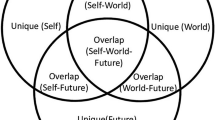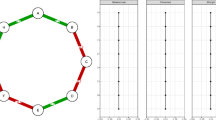Abstract
Despite considerable studies focused on the symptoms of posttraumatic stress disorder (PTSD), little is understood about how symptoms of PTSD naturalistically change over time. Using network analyses approaches, the current study aimed to understand the nature of the association between PTSD symptoms at different time points among adolescents who experienced an earthquake. This study enrolled 900 youth survivors who completed 3 assessments with the Child PTSD Symptom Scale at 1 year, 1.5 years, and 2 years after the Wenchuan earthquake. A graphical Gaussian model (GGM) was used to investigate how symptom networks changed across these time points and to identify the symptoms that were the most central within the network. Results from GGM indicated that different symptoms were observed to have highest centrality at different time points. Feeling distant or cut off from others, avoid thoughts and feelings about the trauma, and feeling irritable or having angry outbursts appeared as the node with highest centrality at 1 year (T1), 1.5 years (T2), and 2 years (T3) post-earthquake, respectively.


Similar content being viewed by others
References
Wu X, Wang W, Zhou X, Chen Q, Lin C (2018) Investigation on mental health state of adolescents after 85 years of Wenchuan earthquake. Psychol Dev Educ 34:80–89
Alisic E, Zalta AK, Van Wesel F, Larsen SE, Hafstad GS, Hassanpour K, Smid GE (2014) Rates of post-traumatic stress disorder in trauma-exposed children and adolescents: meta-analysis. Brit J Psychiat 204(5):335–340
Bolton D, Hill J, O'Ryan D, Udwin O, Boyle S, Yule W (2004) Long-term effects of psychological trauma on psychosocial functioning. J Child Psychol 45(5):1007–1014
Morgan L, Scourfield J, Williams D, Jasper A, Lewis G (2003) The Aberfan disaster: 33-year follow-up of survivors. Brit J Psychiat 182(6):532–536
Beaton RD, Murphy SA, Houston JB, Reyes G, Bramwell S, McDaniel M et al (2009) The role of public health in mental and behavioral health in children and families following disasters. J Public Health Man 15(6):E1–E11
Norris FH, Friedman MJ, Watson PJ, Byrne CM, Diaz E, Kaniasty K (2002) 60,000 disaster victims speak: part I. An empirical review of the empirical literature, 1981–2001. Psychiatry 65(3):207–239
Meiser-Stedman R, McKinnon A, Dixon C, Boyle A, Smith P, Dalgleish T (2019) A core role for cognitive processes in the acute onset and maintenance of post-traumatic stress in children and adolescents. J Child Psychol 60(8):875–884
An YY, Yuan GZ, Wu XC, Wang WC (2018) The influence of social support on PTSD and PTG of adolescents after earthquake: the mediating role of self-efficacy. Psychological Development and Education 34(1):98–104
Yuan G, Xu W, Liu Z, Liu C, Li W, An Y (2018) Dispositional mindfulness, posttraumatic stress disorder symptoms and academic burnout in Chinese adolescents following a tornado: the role of mediation through regulatory emotional self-efficacy. J Aggress Maltreat Trauma 27(5):487–504
Brewin C (2003) Posttraumatic stress disorder: malady or myth?. Yale University Press, New Haven
McNally RJ (2012) The ontology of posttraumatic stress disorder: natural kind, social construction, or causal system? Clin Psychol-Sci Prog 19(3):220–228
Rosen G (ed) (2004) Posttraumatic stress disorder: issues and controversies. Wiley, Hoboken
American Psychiatric Association (1980) Diagnostic and statistical manual of mental disorders, 3rd edn. American Psychiatric Association, Washington, DC
McNally RJ (2016) Can network analysis transform psychopathology? Behav Res Ther 86:95–104
Borsboom D (2017) A network theory of mental disorders. World Psychiatry 16(1):5–13
Cramer AO, Waldorp LJ, Van Der Maas HL, Borsboom D (2010) Comorbidity: a network perspective. Behav Brain Sci 33(2–3):137–150
Kendler KS, Zachar P, Craver C (2011) What kinds of things are psychiatric disorders? Psychol Med 41(6):1143–1150
Bryant RA, Creamer M, O’Donnell M, Forbes D, McFarlane AC, Silove D, Hadzi-Pavlovic D (2017) Acute and chronic posttraumatic stress symptoms in the emergence of posttraumatic stress disorder: a network analysis. JAMA Psychiat 74(2):135–142
Fried EI, Cramer AO (2017) Moving forward: challenges and directions for psychopathological network theory and methodology. Perspect Psychol Sci 12(6):999–1020
Armour C, Fried EI, Deserno MK, Tsai J, Pietrzak RH (2017) A network analysis of DSM-5 posttraumatic stress disorder symptoms and correlates in US military veterans. J Anxiety Disord 45:49–59
Bringmann LF, Elmer T, Epskamp S, Krause RW, Schoch D, Wichers M et al (2018) What do centrality measures measure in psychological networks. J Abnorm Psychol 128(8):892
Borsboom D, Cramer AO (2013) Network analysis: an integrative approach to the structure of psychopathology. Annu Rev Clin Psychol 9:91–121
Afzali MH, Sunderland M, Teesson M, Carragher N, Mills K, Slade T (2017) A network approach to the comorbidity between posttraumatic stress disorder and major depressive disorder: the role of overlapping symptoms. J Affect Disord 208:490–496
Spiller TR, Schick M, Schnyder U, Bryant RA, Nickerson A, Morina N (2017) Symptoms of posttraumatic stress disorder in a clinical sample of refugees: a network analysis. Eur J Psychotraumatol 8(sup3):1318032
Knefel M, Tran US, Lueger-Schuster B (2016) The association of posttraumatic stress disorder, complex posttraumatic stress disorder, and borderline personality disorder from a network analytical perspective. J Anxiety Disord 43:70–78
Cao X, Wang L, Cao C, Fang R, Chen C, Hall BJ, Elhai JD (2019) Depicting the associations between different forms of psychopathology in trauma-exposed adolescents. Eur Child Adoles Psychiatry. https://doi.org/10.1007/s00787-019-01400-x
Benfer N, Bardeen JR, Cero I, Kramer LB, Whiteman SE, Rogers TA et al (2018) Network models of posttraumatic stress symptoms across trauma types. J Anxiety Disord 58:70–77
McNally RJ, Robinaugh DJ, Wu GW, Wang L, Deserno MK, Borsboom D (2015) Mental disorders as causal systems: a network approach to posttraumatic stress disorder. Clin Psychol Sci 3(6):836–849
Sullivan CP, Smith AJ, Lewis M, Jones RT (2018) Network analysis of PTSD symptoms following mass violence. Psychol Trauma-US 10(1):58
Mitchell KS, Wolf EJ, Bovin MJ, Lee LO, Green JD, Rosen RC et al (2017) Network models of DSM-5 posttraumatic stress disorder: implications for ICD-11. J Abnorm Psychol 126(3):355
Russell JD, Neill EL, Carrion VG, Weems CF (2017) The network structure of posttraumatic stress symptoms in children and adolescents exposed to disasters. J Am Acad Child Adolesc Psychiatr 56:669–677
Bartels L, Berliner L, Holt T, Jensen T, Jungbluth N, Plener P et al (2019) The importance of the DSM-5 posttraumatic stress disorder symptoms of cognitions and mood in traumatized children and adolescents: two network approaches. J Child Psychol Psychiatry. https://doi.org/10.1111/jcpp.13009
Geng F, Zhou Y, LiangY ZX, Li Y, ChenFan XF (2019) Posttraumatic stress disorder and psychiatric comorbidity among adolescent earthquake survivors: a longitudinal cohort study. J Abnorm Child Psychiatry 47:671–681
Ge F, Yuan M, Li Y, Zhang J, Zhang W (2019) Changes in the network structure of posttraumatic stress disorder symptoms at different time points among youth survivors: a network analysis. J Affect Disord 259:288–295
Foa EB, Johnson KM, Feeny NC, Treadwell KR (2001) The child PTSD symptom scale: a preliminary examination of its psychometric properties. J Clin Child Psychol 30(3):376–384
Epskamp S, Fried EI (2016) A primer on estimating regularized psychological networks. https://arxiv.org/abs/160701367
Friedman J, Hastie T, Tibshirani R (2014) glasso: graphical lasso-estimation of Gaussian graphical models. R packageversion: 1
Epskamp S, CramerAO WLJ, Schmittmann VD, Borsboom D (2012) qgraph: network visualizations of relationships in psychometric data. J Stat Softw 48(4):1–18
Epskamp S, BorsboomD FEI (2018) Estimating psychological networks and their accuracy: a tutorial paper. Behav Res Methods 50(1):195–212
Fruchterman TM, Reingold EM (1991) Graph drawing by force-directed placement. Soft Pract Exp 21:1129–1164
Friedman J, Hastie T, Tibshirani R (2008) Sparse inverse covariance estimation with the graphical lasso. Biostatistics 9(3):432–441
Foygel R, Drton M (2010) Extended Bayesian information criteria for Gaussian graphical models. In: Advances in neural information processing systems, pp 604–612
Epskamp S, Fried EI (2018) A tutorial on regularized partial correlation networks. Psychol Methods 23(4):617
Freeman LC (1978) Centrality in social networks conceptual clarification. Soc Netw 1(3):215–239
Opsahl T, Agneessens F, Skvoretz J (2010) Node centrality in weighted networks: generalizing degree and shortest paths. Soc Netw 32(3):245–251
Costenbader E, Valente TW (2003) The stability of centrality measures when networks are sampled. Soc Netw 25(4):283–307
Fried EI, Nesse RM (2014) The impact of individual depressive symptoms on impairment of psychosocial functioning. PLoS ONE 9(2):e90311
Terluin B, de Boer MR, de Vet HC (2016) Differences in connection strength between mental symptoms might be explained by differences in variance: reanalysis of network data did not confirm staging. PLoS ONE 11(11):e0155205
Moshier SJ, Bovin MJ, Gay NG, Wisco BE, Mitchell KS, Lee DJ et al (2018) Examination of posttraumatic stress disorder symptom networks using clinician-rated and patient-rated data. J Abnorm Psychol 127(6):541
Birkeland MS, Heir T (2017) Making connections: exploring the centrality of posttraumatic stress symptoms and covariates after a terrorist attack European. Eur J Psychotraumatol 8(sup3):1333387
Fried EI, Eidhof MB, Palic S, Costantini G, Huisman-van Dijk HM, Bockting CL et al (2018) Replicability and generalizability of posttraumatic stress disorder (PTSD) networks: a cross-cultural multisite study of PTSD symptoms in four trauma patient samples. Clin Psychol Sci 6(3):335–351
Litz BT, Orsillo SM, Friedman M, Ehlich P, Batres A (1997) Posttraumatic stress disorder associated with peacekeeping duty in Somalia for US military personnel. Am J Psychiatry 154(2):178–184
Saul AL, Grant KE, Carter JS (2008) Post-traumatic reactions in adolescents: how well do the DSM-IV PTSD criteria fit the real life experience of trauma exposed youth? J Abnorm Child Psychiatry 36(6):915–925
Shallcross SL, Arbisi PA, Polusny MA, Kramer MD, Erbes CR (2016) Social causation versus social erosion: comparisons of causal models for relations between support and PTSD symptoms. J Trauma Stress 29(2):167–175
Erbes CR, Meis LA, Polusny MA, Compton JS, Wadsworth SM (2012) An examination of PTSD symptoms and relationship functioning in US soldiers of the Iraq war over time. J Trauma Stress 25(2):187–190
Lambert JE, Engh R, HasbunA HJ (2012) Impact of posttraumatic stress disorder on the relationship quality and psychological distress of intimate partners: a meta-analytic review. J Fam Psychol 26(5):729
Funding
This study was funded by The National Science Foundation of the Jiangsu Higher Education Institutions of China (grant number 18KJB190004); The Philosophy and Social Science Foundation of Jiangsu (grant number 18SHC004); The Natural Science Foundation of Jiangsu Province for Youth (grant number BK20190702); and The Philosophy and Social Sciences of Jiangsu Higher Education Institutions (grant number 2018SJZDI206).
Author information
Authors and Affiliations
Contributions
All authors contributed to the study conception and design. The first draft of the manuscript was written by [Yuanyuan An] and all authors commented on previous versions of the manuscript. All authors read and approved the final manuscript.
Corresponding author
Ethics declarations
Conflict of interest
The authors declare that they have no conflict of interest.
Ethical Approval
All procedures performed in studies involving human participants were in accordance with the ethical standards of the Faculty of Psychology, Beijing Normal University and with the 1964 Helsinki declaration and its later amendments or comparable ethical standards.
Additional information
Publisher's Note
Springer Nature remains neutral with regard to jurisdictional claims in published maps and institutional affiliations.
Electronic supplementary material
Below is the link to the electronic supplementary material.
Rights and permissions
About this article
Cite this article
An, Y., Hu, CP., Zhao, J. et al. Changes in the Network Structure of Post-traumatic Stress Disorder Symptoms Among Earthquake Exposed Adolescents in China: A 2-Year Longitudinal Study. Child Psychiatry Hum Dev 52, 104–113 (2021). https://doi.org/10.1007/s10578-020-00995-6
Published:
Issue Date:
DOI: https://doi.org/10.1007/s10578-020-00995-6




